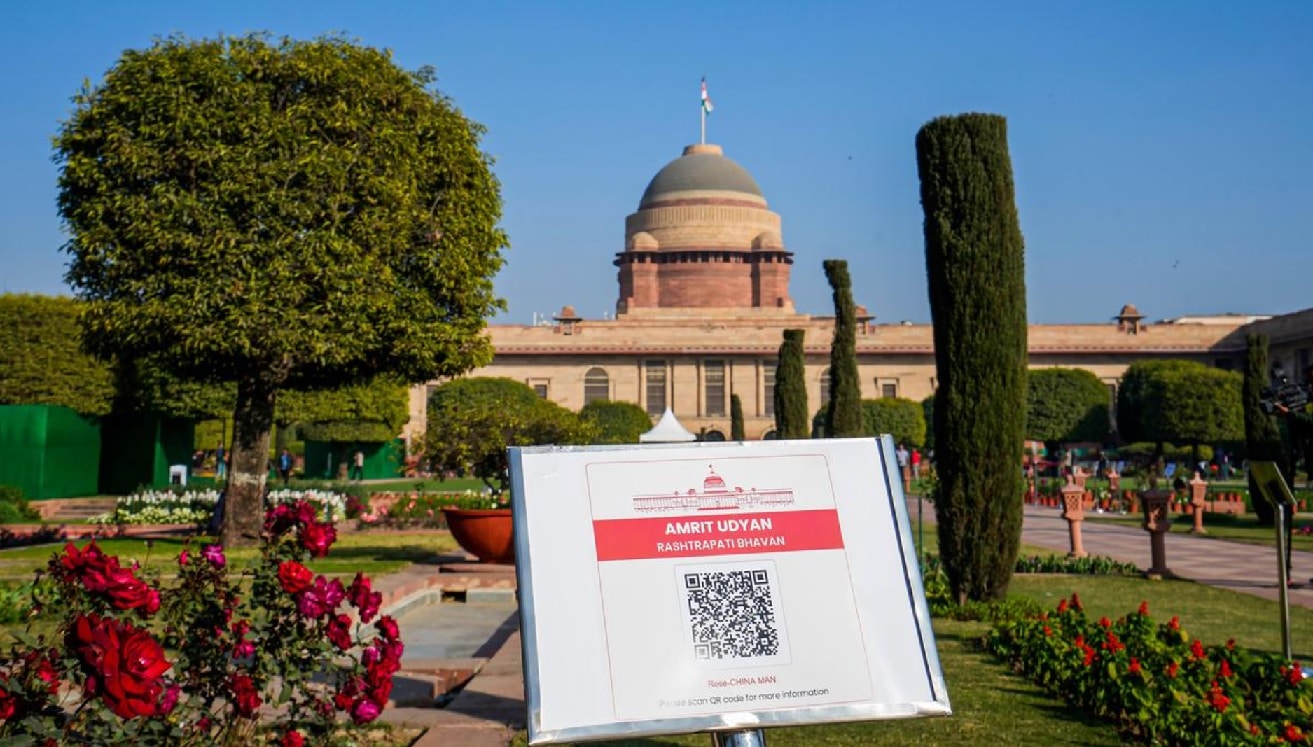What’s in today’s article?
- Why in news?
- What is the history of Mughal Gardens in India?
- How did the Rashtrapati Bhavan get Mughal Gardens?
- Evolution of Mughal Garden at Rshtrapati Bhavan
Why in news?
- The iconic Mughal Gardens at the Rashtrapati Bhavan (President’s House) in Delhi have been renamed as Amrit Udyan.
- The cluster of about 15 gardens will collectively be known as Amrit Udyan.
- Individual gardens within the sprawling Presidential Estate — Herbal Garden, Musical Garden and Spiritual Garden — will retain their names.
What is the history of Mughal Gardens in India?
- The Mughals were known to appreciate gardens. In Babur Nama, Babur says that his favourite kind of garden is the Persian Charbagh style (literally, four gardens).
- Defined by its rectilinear layouts, d ivided in four equal sections, these gardens can be found across lands previously ruled by the Mughals.
- From the gardens surrounding Humanyun’s Tomb in Delhi to the Nishat Bagh in Srinagar, all are built in this style – giving them the moniker of Mughal Gardens.
- A defining feature of these gardens is the use of waterways, often to demarcate the various quadrants of the garden.
- These were not only crucial to maintain the flora of the garden, they also were an important part of its aesthetic.
- Fountains were often built, symbolising the cycle of life.
How did the Rashtrapati Bhavan get Mughal Gardens?
- In 1911, the British decided to shift the Indian capital from Calcutta to Delhi.
- About 4,000 acres of land was acquired to construct the Viceroy’s House with Sir Edwin Lutyens being given the task of designing the building on Raisina Hill.
- Lutyens’ designs combined elements of classical European architecture with Indian styles, producing a unique aesthetic that defines Lutyens’ Delhi till date.
- Crucial in the design of the Viceroy’s House was a large garden in its rear. The initial plans involved creating a garden with traditional British architecture.
- However, the wife of the then Viceroy wanted something in the Mughal style and urged the planners to create a garden in that style.
- It is believed that she was inspired by the book Gardens of the Great Mughals (1913) by Constance Villiers-Stuart as well as her visits to Mughal gardens in Lahore and Srinagar.
Evolution of Mughal Garden at Rshtrapati Bhavan
- The gardens have evolved over time. While roses remain the star attraction, residents of the Rashtrapati Bhavan have all added their own personal touch to the garden.
- E.g., C Rajagopalachari, the last Governor General of India, made a political statement when during a period of food shortage in the country, he himself ploughed the lands and dedicated a section of the garden to foodgrains.
- Today, the Nutrition Garden, popularly known as Dalikhana, stands in that spot, organically cultivating a variety of vegetables for consumption at the Rashtrapati Bhavan.
- President R Venkatraman added a cactus garden and APJ Abdul Kalam added many theme based gardens: from the musical garden to the spiritual garden.
Q1) Who was the last Mughal emperor?
The last Mughal emperor was Bahadur Shah II, also known as Zafar. He died in a British prison in Burma in 1862.
Q2) What was built by Edwin Lutyens?
English architect Sir Edwin Landseer Lutyens (March 29, 1869 – January 1, 1944) has been credited with shaping the pre-independence British capital of New Delhi, with iconic buildings such as the Rashtrapati Bhavan, Viceroy’s House, Lutyens’ Bungalow Zone, Baroda House, Bikaner House, Hyderabad House, and Patiala House.
Source: Rashtrapati Bhavan’s Mughal Gardens renamed: a brief history | Times Now | The Hindu
Last updated on December, 2025
→ Check out the latest UPSC Syllabus 2026 here.
→ Join Vajiram & Ravi’s Interview Guidance Programme for expert help to crack your final UPSC stage.
→ UPSC Mains Result 2025 is now out.
→ UPSC Notification 2026 is scheduled to be released on January 14, 2026.
→ UPSC Calendar 2026 is released on 15th May, 2025.
→ The UPSC Vacancy 2025 were released 1129, out of which 979 were for UPSC CSE and remaining 150 are for UPSC IFoS.
→ UPSC Prelims 2026 will be conducted on 24th May, 2026 & UPSC Mains 2026 will be conducted on 21st August 2026.
→ The UPSC Selection Process is of 3 stages-Prelims, Mains and Interview.
→ UPSC Result 2024 is released with latest UPSC Marksheet 2024. Check Now!
→ UPSC Prelims Result 2025 is out now for the CSE held on 25 May 2025.
→ UPSC Toppers List 2024 is released now. Shakti Dubey is UPSC AIR 1 2024 Topper.
→ UPSC Prelims Question Paper 2025 and Unofficial Prelims Answer Key 2025 are available now.
→ UPSC Mains Question Paper 2025 is out for Essay, GS 1, 2, 3 & GS 4.
→ UPSC Mains Indian Language Question Paper 2025 is now out.
→ UPSC Mains Optional Question Paper 2025 is now out.
→ Also check Best IAS Coaching in Delhi

















